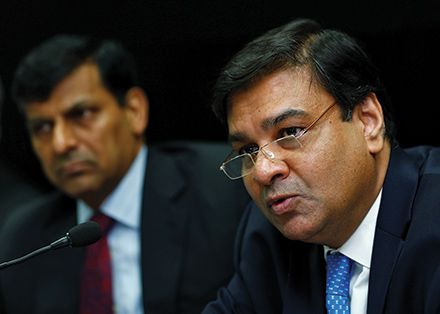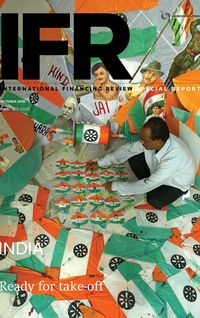Urjit Patel, the new head of the Reserve Bank of India, is viewed as a harmonising figure. His first challenge: to clean up the country’s public banks, and get them to lend again.
Successful central banks should be boring, former Bank of England governor Mervyn King was fond of saying. Those who oversee these powerful institutions are, in the main, intellectually vigorous yet somehow lifeless: stilted, wooden, intentionally invisible.
Raghuram Rajan was manifestly not a member of this grey tribe. When chosen in September 2013 to head up the Reserve Bank of India, he had already lived a multiplicity of lives. The youngest chief economist of the International Monetary Fund; inaugural winner of the American Finance Association’s Fischer Black Prize; professor of finance at the prestigious University of Chicago Booth School of Business.
Rajan was viewed in many Indian circles as an outsider, despite his impeccable establishment credentials. On the one hand, he had served as an honorary economic advisor to former premier Manmohan Singh, and, prior to his elevation to the helm of the RBI, as chief adviser to former finance minister Kaushik Basu.
Yet he was never less than quotable, nor unwilling to risk a sharp-eyed prediction, even when working from inside the tent. He predicted the global financial crisis in a 2005 speech that included a rebuke of laissez-faire regulators and former Federal Reserve chairman Alan Greenspan. In the wake of the crisis, he disparaged bankers for “slavering after bonuses” after seeing their employers bailed out by governments. “He was a very cerebral and talented man who wasn’t afraid to speak his mind, and who brought a rock-star image to the job,” said Deepak Lalwani, founder of India-focused brokerage Lalcap.
Even after becoming head of India’s central bank, he remained an iconoclast. Tall, handsome, and intellectually dominant, Rajan was rarely the second-best-informed person in any room. He continued to berate those he deemed a danger to global financial stability – a sign of his innate penchant for steadiness and stability – by slating Western central banks for their addiction to quantitative easing. And he fought a long battle against two Indian premiers, first Singh then current leader Narendra Modi, to secure autonomy over interest rate decisions.
Patel appears determined to find a middle path acceptable to all. He has hinted that he may dispense with the deep-surgery diagnosis of his predecessor, and seek a way to deal with the bad-loan problem, while encouraging publicly owned banks to lend again.
At first, his dash and dynamism was a welcome break from the norm, and exactly what the country needed. India’s economy was then in a very dark place. Economic growth had fallen from more than 10% in 2010 to an average of 6.1% in 2012 and 2013, while the rupee was in freefall. Inflation, a longstanding scourge, hit 11.1% in 2012, with the current account deficit topping 5%. Morgan Stanley famously included India as one of five emerging markets deemed too dependent on volatile flows of foreign capital to fund its growth ambitions.
“When Rajan arrived at the RBI, he faced immense challenges, which he handled deftly,” said Kapil Gupta, chief economist at Mumbai-based Edelweiss Securities. “Prices were rising, deficits were widening, and growth was slowing. It was a perfect storm. India needed macro strength, and Rajan provided that. His aim was to instil and maintain fiscal prudence, and above all to fight inflation.”
That he succeeded is beyond doubt. Inflation has fallen steadily since late 2013, hitting 4.2% in September 2016. The current account deficit narrowed to 1.1% in the Indian financial year to end-March 2016, and is tipped by DBS to dip below 1% in the current 12-month period. Rajan’s main achievement, said Kunal Kumar Kundu, India economist at Société Générale, was “to transform the RBI into a credible regulatory institution. Under him, it became an inflation-targeting central bank, and Rajan fought to introduce a proper monetary policy committee [MPC]. He left behind a great legacy.”
Yet as India’s economy began to improve, Rajan’s agenda began to irritate senior domestic lawmakers. He refused to budge on interest rates, maintaining them at 8% well into 2015. Politicians muttered that his recalcitrance was stunting economic growth – though SocGen’s Kundu said the investment climate was hampered less by monetary policy and more by a “weak business confidence, and a profligate government that did not believe as much in fiscal discipline”.
Sometimes the barbs went deeper: senior voices in the ruling Bharatiya Janata Party whispered that Rajan, who has long held a US green card, wasn’t a ‘real’ Indian citizen at heart. Sometimes, the RBI chief stepped beyond his remit, once warning against giving credence to “anyone imposing a particular view or ideology because of their power” – an observation viewed by some in the BJP as straying dangerously close to a political statement.
By June 2016, it was clear his time at the central bank was drawing to a close. Reports that he did not see eye-to-eye with Modi could no longer be ignored. Nor could rumours that the prickly premier saw Rajan as a too colourful and media-friendly. A departure date was set for September 4, marking his third anniversary on the job; the last person to spend so little time at the helm of the RBI was S. Venkitaramanan, whose tenure in the early 1990s coincided with the first Gulf War and India’s near-bankruptcy.
Polar opposite
Rajan’s replacement, Urjit Patel, is in many ways his polar opposite. The two were close, with Rajan assigning his deputy to oversee the formation of a six-person MPC, which includes the central bank chief and three government-appointed economists. Yet where the outgoing chief was forceful and, at times, a little brash, his successor is quiet, measured and self-effacing, the archetypal civil servant. “He’s a very private guy, someone who likes to avoid the limelight,” said Lalcap’s Lalwani. “He’s ‘old-style’ central bank.”
At the time, many saw the appointment as a step in the wrong direction. Rajan’s ability to take the long view, UBS said in a June 20 research note, was “precisely what was needed to finance long-term growth”, while his departure created “uncertainty over India’s long-term [monetary] policy”.
Concerns that the private and mild-mannered Patel would be more amenable to the demands of the Modi administration have so far proven to be on the mark. Patel’s first test was on October 4, marking the first time the newly minted MPC got to decided the trajectory of interest rates. Would they keep rates as they were and remain focused on combating inflation, or cut them?
In the end, Patel & Co took the latter route, voting overwhelmingly to lower the benchmark rate by 25 basis points to 6.25%, the lowest rate since January 2011. The move surprised analysts, most of whom, believing that India’s robust economy needed no additional help, had tipped rates to stay on hold.
To some observers, it was a sign that Patel was willing to break with his more hawkish predecessor, and take the gamble that lower rates would boost growth rather than reigniting inflation. Many viewed the decision to cut rates as politically motivated. A few weeks before the MPC’s inaugural meeting, finance minister Arun Jaitley argued in favour of a looser monetary policy, citing falling retail inflation, rising growth rates, and a good monsoon season.
Patel has been careful to keep intact the most inviolate targets of his predecessor, notably the aim of keeping consumer price inflation at 4% through 2021, within a 2%–6% range. Few see inflation being a serious near-term worry. Low global oil prices have been a major boon to resource-poor India. Edelweiss Securities’ Gupta sees “inflation remaining benign” through the first and second quarters of 2017. “That will give comfort to the RBI that it can continue to underpin growth,” he said. “I see rates being cut by another 25 basis points by the end of the year, with more cuts heading into 2017.”
Others fret that Patel is overly dovish – that he has chosen to believe that low inflation is here to stay. “Our apprehension of him being open to accepting a higher inflation threshold – by shifting the 4% inflation target from March 2018 to March 2021 – has come true,” said SocGen’s Kundu.
Toxic assets
There are also signs that, under Patel, the RBI has softened its view on how to resolve a huge pool of toxic assets held by state lenders. Stressed loans in India’s banking sector totalled US$138bn at end-June 2016, up 15% in six months. A September report from Credit Suisse said impaired assets as a share of total lending was 12%, with the non-performing loan ratio at 8.6%, and the share of restructured loans classified as bad or failing loans at 43%.
Rajan’s approach had been to launch a US$120bn clean-up plan aimed at sanitising the bulk of the soured lending out of the system – in effect, to force banks to recover and resolve their own debts. Many analysts decried this approach, calling it heavy-handed. While well intentioned, Rajan’s actions prompted banks to jack up provisioning levels and slash bonuses. State lenders, struggling to assess the true value of the loans held on their books, were paralysed into inaction. An October report from Kotak Institutional Equities tipped bank earnings to decline 15% year-on-year in 2016. “While it is necessary to clean up the banking system, deep surgery is not advisable when the patient is anaemic,” warned SocGen’s Kundu.
Patel appears determined to find a middle path acceptable to all. He has hinted that he may dispense with the deep-surgery diagnosis of his predecessor, and seek a way to deal with the bad-loan problem, while encouraging publicly owned banks to lend again. The most likely way to achieve this is to set up a ‘bad bank’ to absorb toxic assets from struggling state lenders, an approach nixed by Rajan but revived by Patel and given an implicit stamp of approval in early October by finance secretary Ashok Lavasa, one of the country’s most senior civil servants. It remains to be seen whether he succeeds or fails. Either way, the new era at India’s central bank will be both more peaceable, and more boring.
To see the digital version of this report, please click here
To purchase printed copies or a PDF of this report, please email gloria.balbastro@tr.com



